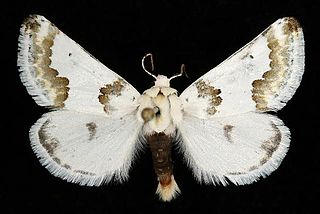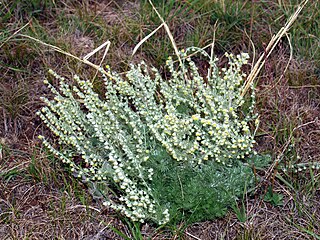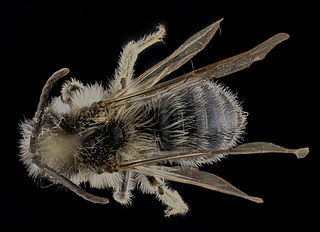
An inversion is a chromosome rearrangement in which a segment of a chromosome is reversed end to end. An inversion occurs when a single chromosome undergoes breakage and rearrangement within itself. Inversions are of two types: paracentric and pericentric.

In molecular genetics, a repressor is a DNA- or RNA-binding protein that inhibits the expression of one or more genes by binding to the operator or associated silencers. A DNA-binding repressor blocks the attachment of RNA polymerase to the promoter, thus preventing transcription of the genes into messenger RNA. An RNA-binding repressor binds to the mRNA and prevents translation of the mRNA into protein. This blocking or reducing of expression is called repression.

The Pierinae are a large subfamily of pierid butterflies. The subfamily is one of several clades of butterflies often referred to as the whites. It includes the following species :
Andreaea frigida, commonly known as icy rockmoss, is a moss endemic to Europe which is found in mountainous regions in Austria, the Czech Republic, France, Germany, Hungary, Italy, Norway, Romania, Poland, and Spain. In the UK its occurrence is widespread in the Cairngorms National Park, where it is typically found on rocks in burns fed by snow patches, but it is not found elsewhere except at a single site in the Lake District of England.

Nitzschia is a common pennate marine diatom. In the scientific literature, this genus, named after Christian Ludwig Nitzsch, is sometimes termed Nitzchia, and it has many species described, which all have a similar morphology.

Schinia cumatilis, the silver-banded gem, is a moth of the family Noctuidae. The species was first described by Augustus Radcliffe Grote in 1865. It is found from the Southwestern United States into Southern Canada.

Leucorrhinia frigida, the frosted whiteface, is a species of dragonfly in the family Libellulidae. It is found in northeastern United States and southern Manitoba, Ontario, Quebec, and New Brunswick.

Pleurotomella frigida is a species of sea snail, a marine gastropod mollusk in the family Raphitomidae.
Salvia frigida is a herbaceous perennial in the family Lamiaceae. It is native to northern Iraq, northwestern Iran, and eastern Turkey growing at 900 to 2,500 m elevation. It is often found growing in Anatolia, on woodland edges, meadows, limestone slopes, and crevices. The specific epithet, frigida, refers to the cold regions where it typically grows.

Coelopa frigida is a species of seaweed fly or kelp fly. It is the most widely distributed species of seaweed fly. It can be found on most shorelines in the temperate Northern Hemisphere. Other species of seaweed flies include Coelopa nebularum and Coelopa pilipes. C. frigida feeds primarily on seaweed, and groups of C. frigida flies tend to populate near bodies of water. Climate change has led to an increase in C. frigida blooms along shores, which creates a pest problem for human beach-goers. C. frigida is also an important organism for the study of sexual selection, particularly female choice, which is influenced by genetics.

Artemisia frigida is a widespread species of flowering plant in the aster family, which is known as the sunflower family. It is native to Europe, Asia, and much of North America. In parts of the north-central and northeastern United States it is an introduced species.
Clystea frigida is a moth of the subfamily Arctiinae. It was described by Hermann Burmeister in 1878. It is found in Argentina.
Bucculatrix frigida is a moth in the family Bucculatricidae. It is found in North America, where it has been recorded from the northern Rocky Mountains (Alberta) and central Alaska. It was described by G. Deschka in 1992.

Arnica griscomii is an Asian and North American species of plants in the sunflower family, known by the common name Snow arnica . It is native to eastern Russia and northwestern North America and to eastern Canada.

The cold miner bee is a species of miner bee in the family Andrenidae. Another common name for this species is the frigid miner. It is found in North America.
Coelopa is a genus of kelp flies in the family Coelopidae. There are about 14 described species in Coelopa.
Hierodoris torrida is a species of moth in the family Oecophoridae. This species is endemic to New Zealand. It is classified as "At Risk, Relict'" by the Department of Conservation.

Hierodoris polita is a species of moth in the family Oecophoridae. It is endemic to New Zealand. This species is classified as "At Risk, Naturally Uncommon" by the Department of Conservation.

Venus Frigida is a 1611 oil on panel painting by Peter Paul Rubens, now in the Royal Museum of Fine Arts Antwerp. It is one of the few works which he both signed and dated and derives its title from a quotation from the Roman playwright Terence, "sine Cerere et Baccho friget Venus" i.e. love cannot survive without food and wine). He draws Venus' crouched pose from what would later be called the Lely Venus, which he saw in the Gonzaga collection during his time in Mantua.

Coelopa pilipes is a common European species of kelp fly. It was described by A. H. Haliday in 1838. Their appearance differs greatly from that of other Coelopa flies.













